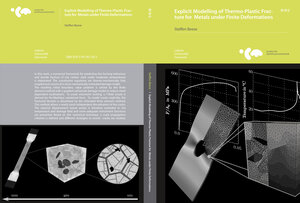
×
![Buchcover ISBN 9783941302303]()
Explicit Modelling of Thermo-Plastic Fracture for Metals under Finite Deformations
von Steffen Beese, herausgegeben von Peter WriggersIn the present work, a numerical framework for predicting the forming
behaviour and ductile fracture of low carbon steel under moderate
temperatures is elaborated. Therefore, a thermodynamically consistent
material model based on the concept of thermo-elastic isomorphism is
developed for the macro scale and for the poly-crystalline
microstructure as well. The constitutive equations are
thermo-mechanically fully coupled and consist of a micro mechanically
motivated damage model. The coupling of the damage model to the
thermo-elastic regime is achieved by studying an artificial micro
structure. The effective stiffness and the effective heat transfer are
analysed for different void volume fractions. The integration of the
constitutive evolution equations of the derived model needs some special
treatment under finite deformation plasticity. Standard integration
schemes fail because they do not fulfil the axiom of isochoric plastic
deformation. In this work, the axiom is enforced by estimating and later
cancelling out the volumetric error. For micromechanical analysis a
thermo-mechanically coupled, visco-plastic regularised
crystal-plasticity model is derived. The artificial microstructure is
generated by taking into account experimentally observed statistical
quantities.
The resulting initial boundary value problem is then transformed to its
weak form and solved by the finite element method (FEM). Softening
materials tend to localise mesh dependently. Therefore, a strategy based
on the fulfilment of an additional balance equation depending on the
damage value and its gradient is applied. To avoid volumetric locking, a
7-field ansatz is derived by Hu-Washizus variational form. This leads to
an element formulation strongly related to the well known Q1P0 element.
To model cracks explicitly, the fractured domain is discretised by the
extended finite element method (XFEM). This method allows a nearly mesh
independent discretisation of the cracks. The classical displacement
based extend finite element method ansatz is therefore extended to the
temperature and damage field and some adequate enrichment functions are
presented. Based on this numerical technique, a crack propagation
criterion is defined and different strategies to evolve the implicitly
modelled crack face are studied. Finally a combination of these
different strategies is proposed and an algorithm for quasi static crack
growth is elaborated. In every chapter numerical examples show the
strengths and weaknesses of the presented methods.
behaviour and ductile fracture of low carbon steel under moderate
temperatures is elaborated. Therefore, a thermodynamically consistent
material model based on the concept of thermo-elastic isomorphism is
developed for the macro scale and for the poly-crystalline
microstructure as well. The constitutive equations are
thermo-mechanically fully coupled and consist of a micro mechanically
motivated damage model. The coupling of the damage model to the
thermo-elastic regime is achieved by studying an artificial micro
structure. The effective stiffness and the effective heat transfer are
analysed for different void volume fractions. The integration of the
constitutive evolution equations of the derived model needs some special
treatment under finite deformation plasticity. Standard integration
schemes fail because they do not fulfil the axiom of isochoric plastic
deformation. In this work, the axiom is enforced by estimating and later
cancelling out the volumetric error. For micromechanical analysis a
thermo-mechanically coupled, visco-plastic regularised
crystal-plasticity model is derived. The artificial microstructure is
generated by taking into account experimentally observed statistical
quantities.
The resulting initial boundary value problem is then transformed to its
weak form and solved by the finite element method (FEM). Softening
materials tend to localise mesh dependently. Therefore, a strategy based
on the fulfilment of an additional balance equation depending on the
damage value and its gradient is applied. To avoid volumetric locking, a
7-field ansatz is derived by Hu-Washizus variational form. This leads to
an element formulation strongly related to the well known Q1P0 element.
To model cracks explicitly, the fractured domain is discretised by the
extended finite element method (XFEM). This method allows a nearly mesh
independent discretisation of the cracks. The classical displacement
based extend finite element method ansatz is therefore extended to the
temperature and damage field and some adequate enrichment functions are
presented. Based on this numerical technique, a crack propagation
criterion is defined and different strategies to evolve the implicitly
modelled crack face are studied. Finally a combination of these
different strategies is proposed and an algorithm for quasi static crack
growth is elaborated. In every chapter numerical examples show the
strengths and weaknesses of the presented methods.


